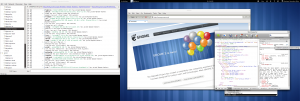Kees Cook: security things in Linux v5.5
 Previously: v5.4.
I got a bit behind on this blog post series! Let s get caught up. Here are a bunch of security things I found interesting in the Linux kernel v5.5 release:
restrict
Previously: v5.4.
I got a bit behind on this blog post series! Let s get caught up. Here are a bunch of security things I found interesting in the Linux kernel v5.5 release:
restrict perf_event_open() from LSMGiven the recurring flaws in the perf subsystem, there has been a strong desire to be able to entirely disable the interface. While the
kernel.perf_event_paranoid sysctl knob has existed for a while, attempts to extend its control to block all perf_event_open() calls have failed in the past. Distribution kernels have carried the rejected sysctl patch for many years, but now Joel Fernandes has implemented a solution that was deemed acceptable: instead of extending the sysctl, add LSM hooks so that LSMs (e.g. SELinux, Apparmor, etc) can make these choices as part of their overall system policy.
generic fast full refcount_tWill Deacon took the recent
refcount_t hardening work for both x86 and arm64 and distilled the implementations into a single architecture-agnostic C version. The result was almost as fast as the x86 assembly version, but it covered more cases (e.g. increment-from-zero), and is now available by default for all architectures. (There is no longer any Kconfig associated with refcount_t; the use of the primitive provides full coverage.)
linker script cleanup for exception tablesWhen Rick Edgecombe presented his work on building Execute-Only memory under a hypervisor, he noted a region of memory that the kernel was attempting to read directly (instead of execute). He rearranged things for his x86-only patch series to work around the issue. Since I d just been working in this area, I realized the root cause of this problem was the location of the exception table (which is strictly a lookup table and is never executed) and built a fix for the issue and applied it to all architectures, since it turns out the exception tables for almost all architectures are just a data table. Hopefully this will help clear the path for more Execute-Only memory work on all architectures. In the process of this, I also updated the section fill bytes on x86 to be a trap (0xCC, int3), instead of a NOP instruction so functions would need to be targeted more precisely by attacks. KASLR for 32-bit PowerPC
Joining many other architectures, Jason Yan added kernel text base-address offset randomization (KASLR) to 32-bit PowerPC. seccomp for RISC-V
After a bit of long road, David Abdurachmanov has added seccomp support to the RISC-V architecture. The series uncovered some more corner cases in the seccomp self tests code, which is always nice since then we get to make it more robust for the future! seccomp
USER_NOTIF continuationWhen the seccomp
SECCOMP_RET_USER_NOTIF interface was added, it seemed like it would only be used in very limited conditions, so the idea of needing to handle normal requests didn t seem very onerous. However, since then, it has become clear that the overhead of a monitor process needing to perform lots of normal open() calls on behalf of the monitored process started to look more and more slow and fragile. To deal with this, it became clear that there needed to be a way for the USER_NOTIF interface to indicate that seccomp should just continue as normal and allow the syscall without any special handling. Christian Brauner implemented SECCOMP_USER_NOTIF_FLAG_CONTINUE to get this done. It comes with a bit of a disclaimer due to the chance that monitors may use it in places where ToCToU is a risk, and for possible conflicts with SECCOMP_RET_TRACE. But overall, this is a net win for container monitoring tools.
EFI_RNG_PROTOCOL for x86Some EFI systems provide a Random Number Generator interface, which is useful for gaining some entropy in the kernel during very early boot. The arm64 boot stub has been using this for a while now, but Dominik Brodowski has now added support for x86 to do the same. This entropy is useful for kernel subsystems performing very earlier initialization whre random numbers are needed (like randomizing aspects of the SLUB memory allocator).
FORTIFY_SOURCE for MIPSAs has been enabled on many other architectures, Dmitry Korotin got MIPS building with
CONFIG_FORTIFY_SOURCE, so compile-time (and some run-time) buffer overflows during calls to the memcpy() and strcpy() families of functions will be detected.
limit copy_ to,from _user() size to INT_MAXAs done for VFS,
vsnprintf(), and strscpy(), I went ahead and limited the size of copy_to_user() and copy_from_user() calls to INT_MAX in order to catch any weird overflows in size calculations.
Other thingsAlexander Popov pointed out some more v5.5 features that I missed in this blog post. I m repeating them here, with some minor edits/clarifications. Thank you Alexander!
- KASan support for vmap memory expands KASan s features to include analysis of memory allocated with
vmalloc(). More specifically, this means KASan can examine the stack again, since it can be in that region sinceCONFIG_VMAP_STACKwas introduced. - MIPS can build with GCC plugins and KCOV now, providing those systems with the associated features like stack wiping, coverage analysis, etc.
- userfaultfd requires CAP_SYS_PTRACE for UFFD_FEATURE_EVENT_FORK. This was done to block unprivileged users from abusing the userfaultfd feature, as it is implemented in a way that provides the ability to inject file descriptors into unsuspecting processes.
2020, Kees Cook. This work is licensed under a Creative Commons Attribution-ShareAlike 3.0 License.
 What happened about the
What happened about the  On IRC, someone pointed out this
On IRC, someone pointed out this 
 My hunch has just been exposed rather dramatically today:
My hunch has just been exposed rather dramatically today:  As an Australian, my own rights and those of my family are more heavily protected and respected living in Europe than if I lived in my country of birth. Australia does not have a
As an Australian, my own rights and those of my family are more heavily protected and respected living in Europe than if I lived in my country of birth. Australia does not have a  Where did all the data go?
As the music industry has found out the hard way, digital data can be copied at will with the originator having no control.
The revelations that Britain and Australia are in on the PRISM shenanigans only confirms that this data is seen as a new form of currency for exchange in geo-political posturing. While used weapons take decades to work their way down the chain, data can spread at the speed of light.
Where did all the data go?
As the music industry has found out the hard way, digital data can be copied at will with the originator having no control.
The revelations that Britain and Australia are in on the PRISM shenanigans only confirms that this data is seen as a new form of currency for exchange in geo-political posturing. While used weapons take decades to work their way down the chain, data can spread at the speed of light.
 Almost every bug tracker for free software projects has a
section for wishlist bugs. Often this results in ever
growing lists of wishes, most of which will never be
fulfilled.
A long list of bugs, even if it is wishlist bugs, is rarely
useful. It's hard to keep track of what is there, and so
the information is not kept up to date when things change.
Even if a wishlist bug gets implemented, the bug is often
overlooked, and remains on the list.
Joel Spolsky calls this
Almost every bug tracker for free software projects has a
section for wishlist bugs. Often this results in ever
growing lists of wishes, most of which will never be
fulfilled.
A long list of bugs, even if it is wishlist bugs, is rarely
useful. It's hard to keep track of what is there, and so
the information is not kept up to date when things change.
Even if a wishlist bug gets implemented, the bug is often
overlooked, and remains on the list.
Joel Spolsky calls this 





 You know, GNOME Shell and I are not really strangers to each other for a long time now. I have been using it almost daily as my main desktop since late 2009, when I started shipping it to Debian experimental. That means that I had ample opportunity to both get used to it and witness the huge improvements it had with every new release.
My general feeling towards GNOME 3 is this: . Yes, I love it! I love the new themes, I love the window borders, I love the top panel, the overview, the dynamic workspaces, I love the Me menu, I love the clock and the calendar, the system indicators with the beautiful symbolic icons, being able to search for applications in such a nice way, the window animations, the multi-screen support, the new nautilus, the dash, looking glass. It s hard for me to even express how thankful I am and how much admiration I have for the awesome folks who helped bring this to life. Thanks so much!
You know, GNOME Shell and I are not really strangers to each other for a long time now. I have been using it almost daily as my main desktop since late 2009, when I started shipping it to Debian experimental. That means that I had ample opportunity to both get used to it and witness the huge improvements it had with every new release.
My general feeling towards GNOME 3 is this: . Yes, I love it! I love the new themes, I love the window borders, I love the top panel, the overview, the dynamic workspaces, I love the Me menu, I love the clock and the calendar, the system indicators with the beautiful symbolic icons, being able to search for applications in such a nice way, the window animations, the multi-screen support, the new nautilus, the dash, looking glass. It s hard for me to even express how thankful I am and how much admiration I have for the awesome folks who helped bring this to life. Thanks so much!


 When most people talk about Ubuntu, they usually mean our flagship product, Ubuntu Desktop Edition. Sometimes, they might mean the Ubuntu project, or the community of people who work on it, or various other things.
Similarly, Debian might mean the Debian operating system, or the package repositories, or the project, and so on.
This gets a little confusing sometimes. When I m talking about Ubuntu, I ve started to use more specific terminology to explain what I mean, and this seems to help people understand better the nature of the whole Ubuntu. In particular, I use the three Ps:
When most people talk about Ubuntu, they usually mean our flagship product, Ubuntu Desktop Edition. Sometimes, they might mean the Ubuntu project, or the community of people who work on it, or various other things.
Similarly, Debian might mean the Debian operating system, or the package repositories, or the project, and so on.
This gets a little confusing sometimes. When I m talking about Ubuntu, I ve started to use more specific terminology to explain what I mean, and this seems to help people understand better the nature of the whole Ubuntu. In particular, I use the three Ps:
 I
I